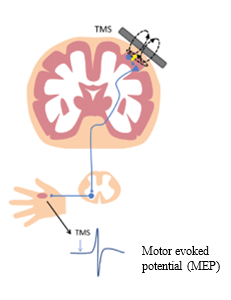TMS
Transcranial magnetic stimulation (TMS) is a safe, painless, non-invasive way of activating neurons in the cortex of the brain.
A brief current is passed through an insulated coil of wire, held against the scalp. The brief current generates a brief and rapidly changing magnetic field, which passes painlessly through the scalp and skull. The magnetic field can induce current flow in the underlying tissues, which can depolarise neurons near the surface of the brain, causing them to fire.
 If the coil is positioned over the primary motor cortex, it can depolarise pyramidal neurons that form the corticospinal tract. When these neurons fire they generate synchronised descending output from the primary motor cortex to the spinal cord, via the corticospinal tract. This descending signal can then activate alpha motor neurons in the spinal cord, generating action potentials that travel along the peripheral nerves to muscles on the opposite side of the body to the hemisphere stimulated. Surface electromyography can be used to detect the arrival of these action potentials in the muscles, observed as a motor evoked potential (MEP).
If the coil is positioned over the primary motor cortex, it can depolarise pyramidal neurons that form the corticospinal tract. When these neurons fire they generate synchronised descending output from the primary motor cortex to the spinal cord, via the corticospinal tract. This descending signal can then activate alpha motor neurons in the spinal cord, generating action potentials that travel along the peripheral nerves to muscles on the opposite side of the body to the hemisphere stimulated. Surface electromyography can be used to detect the arrival of these action potentials in the muscles, observed as a motor evoked potential (MEP).
TMS can also be used to activate other areas of the cortex, such as premotor, parietal, and frontal cortex, as well as the cerebellum. Neuronavigation is often used to ensure the coil is correctly positioned over these other areas, as MEPs cannot be recorded to confirm correct coil location.
If TMS is new territory, this article is a good place to start.
Hallett, M. Transcranial magnetic stimulation: a primer.
Neuron 2007 55(2): 187-199
DOI: 10.1016/j.neuron.2007.06.026 PMID: 17640522


